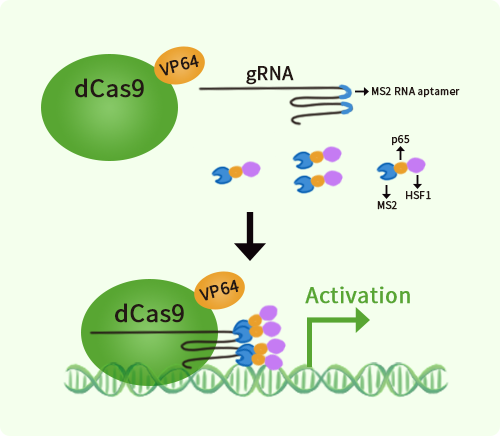Human UBL4A activation kit by CRISPRa
CAT#: GA105459
UBL4A CRISPRa kit - CRISPR gene activation of human ubiquitin like 4A
Find the corresponding CRISPRi Inhibitor Kit
USD 1,290.00
2 Weeks*
Specifications
| Product Data | |
| Format | 3gRNAs, 1 scramble ctrl and 1 enhancer vector |
| Symbol | UBL4A |
| Locus ID | 8266 |
| Kit Components | GA105459G1, UBL4A gRNA vector 1 in pCas-Guide-CRISPRa GA105459G2, UBL4A gRNA vector 2 in pCas-Guide-CRISPRa GA105459G3, UBL4A gRNA vector 3 in pCas-Guide-CRISPRa 1 CRISPRa-Enhancer vector, SKU GE100056 1 CRISPRa scramble vector, SKU GE100058 |
| Disclaimer | The kit is designed based on the best knowledge of CRISPa SAM technology. The efficiency of the activation can be affected by many factors, including nucleosome occupancy status, chromatin structure and the gene expression level of the target, etc. |
| Reference Data | |
| RefSeq | NM_014235 |
| Synonyms | DX254E; DXS254E; G6PD; GDX; GET5; MDY2; TMA24; UBL4 |
| Summary | As part of a cytosolic protein quality control complex, the BAG6/BAT3 complex, maintains misfolded and hydrophobic patches-containing proteins in a soluble state and participates to their proper delivery to the endoplasmic reticulum or alternatively can promote their sorting to the proteasome where they undergo degradation (PubMed:20676083, PubMed:21636303, PubMed:21743475, PubMed:28104892). The BAG6/BAT3 complex is involved in the post-translational delivery of tail-anchored/type II transmembrane proteins to the endoplasmic reticulum membrane. Recruited to ribosomes, it interacts with the transmembrane region of newly synthesized tail-anchored proteins and together with SGTA and ASNA1 mediates their delivery to the endoplasmic reticulum (PubMed:20676083, PubMed:28104892). Client proteins that cannot be properly delivered to the endoplasmic reticulum are ubiquitinated and sorted to the proteasome (PubMed:28104892). Similarly, the BAG6/BAT3 complex also functions as a sorting platform for proteins of the secretory pathway that are mislocalized to the cytosol either delivering them to the proteasome for degradation or to the endoplasmic reticulum (PubMed:21743475). The BAG6/BAT3 complex also plays a role in the endoplasmic reticulum-associated degradation (ERAD), a quality control mechanism that eliminates unwanted proteins of the endoplasmic reticulum through their retrotranslocation to the cytosol and their targeting to the proteasome. It maintains these retrotranslocated proteins in an unfolded yet soluble state condition in the cytosol to ensure their proper delivery to the proteasome (PubMed:21636303). [UniProtKB/Swiss-Prot Function] |
Documents
| Product Manuals |
| FAQs |
| SDS |
Resources
Other Versions
| SKU | Description | Size | Price |
|---|---|---|---|
| KN408121 | UBL4A - KN2.0, Human gene knockout kit via CRISPR, non-homology mediated. |
USD 1,290.00 |
{0} Product Review(s)
Be the first one to submit a review






























































































































































































































































 Germany
Germany
 Japan
Japan
 United Kingdom
United Kingdom
 China
China
